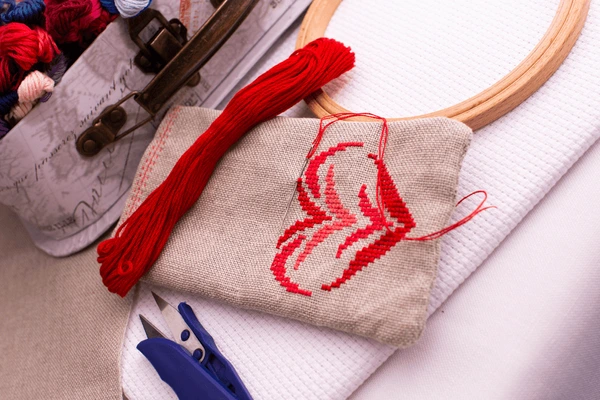Have you ever admired a beautifully embroidered piece and thought, “I wish I could make something like that”? Good news!
You can easily dive into the world of embroidery with the help of kits, even if you’re a complete beginner. These kits are your all-in-one solution, providing everything you need to create stunning designs right at your fingertips. Imagine the joy of turning a simple piece of fabric into a work of art that you can proudly display or gift to a loved one.
Plus, embroidery is a wonderful way to unwind and express your creativity. Ready to discover how you can master the art of embroidery effortlessly? Stick around to find out how you can get started today!
Credit: folksy.com
Choosing The Right Embroidery Kit
Embroidery is a delightful craft that combines creativity and precision. Choosing the right embroidery kit is crucial for beginners and seasoned crafters alike. The right kit can make your crafting experience enjoyable and rewarding. It provides all necessary materials and instructions for your project.
Types Of Kits Available
Embroidery kits come in various styles and themes. Some kits focus on cross-stitching, which uses X-shaped stitches to form patterns. Others are designed for needlepoint projects, perfect for creating detailed designs. There are kits for crewel embroidery, which uses wool threads for textured designs. Beginner kits include simple patterns and easy-to-follow guides. More advanced kits offer complex designs for experienced embroiderers.
Factors To Consider
Consider the skill level required for the kit. Beginners should start with simple patterns to build confidence. Check the materials included in the kit. Quality threads and fabrics enhance the final result. Instructions should be clear and easy to understand. Look for kits with detailed guides and illustrations. Consider the design theme and size of the finished piece. Choose a kit that matches your interest and available time.

Credit: www.amazon.com
Essential Tools And Materials
Embroidery kits make crafting simple. They come with all the basics needed. This saves time and ensures a smooth start. But understanding each tool is key. Let’s dive into the essentials for embroidery success.
Needles And Threads
Needles are vital for embroidery work. Choose the right size for your project. Smaller needles suit fine fabrics. Larger needles work with thicker materials. Threads come in many colors and types. Cotton threads are common. They are durable and easy to handle. Silk threads add a shiny touch. They are perfect for special projects. Always select high-quality threads for best results.
Hoops And Fabrics
Hoops keep fabric tight. This ensures neat and even stitches. Choose hoops that fit your fabric size. They come in wood or plastic options. Both work well for beginners. Fabrics are the canvas for your art. Cotton fabrics are popular and easy to use. Linen offers a textured finish. It’s great for advanced designs. Always ensure your fabric is clean and smooth. This helps in producing a flawless embroidery piece.
Basic Stitches For Beginners
Embroidery offers a delightful way to express creativity. For beginners, mastering basic stitches is essential. With the right techniques, even a simple design can look beautiful. This guide will introduce you to three fundamental stitches. You’ll soon be ready to embark on your embroidery journey.
Running Stitch
The running stitch is simple and versatile. It involves a series of small, even stitches. The needle goes in and out of the fabric. This creates a dashed line. It’s great for outlining shapes or adding a delicate touch. Beginners find it easy to learn.
Backstitch
The backstitch provides a solid, continuous line. Start by making a single stitch. Then, bring the needle forward. Insert it back into the end of the previous stitch. This creates a seamless line. Ideal for outlines and lettering. It adds a polished look to your work.
Satin Stitch
The satin stitch fills areas with solid color. Begin by outlining the shape. Then, fill the area with parallel stitches. Ensure the stitches are close together. This creates a smooth, shiny surface. Perfect for leaves, petals, or any solid shape. With practice, the satin stitch becomes easier.

Credit: www.reddit.com
Preparing Your Embroidery Project
Embroidery is a fascinating craft that allows creative expression through threads and needles. To begin your embroidery journey, preparing your project is crucial. This process involves setting up your workspace and transferring patterns onto your fabric. Proper preparation ensures a smooth and enjoyable experience. It also helps achieve beautiful results. Let’s explore how to get your embroidery project ready with these essential steps.
Setting Up Your Work Area
Your work area affects your embroidery project. Choose a spot with good lighting. Natural light is ideal for seeing thread colors clearly. Arrange your tools within reach. Keep scissors, needles, and threads organized. Use a comfortable chair to avoid strain. Ensure your table is at a suitable height. This prevents discomfort during long sessions. A tidy workspace boosts creativity and focus. Preparing your area well makes the process enjoyable.
Transferring Patterns
Transferring patterns is a key part of embroidery preparation. Start with selecting your fabric. Choose one that suits your design. Prepare your pattern by printing or tracing it. Use a light box or window to trace designs onto fabric. Ensure lines are clear and visible. Transfer techniques vary based on fabric type. For cotton, use transfer pens or pencils. For delicate fabrics, try chalk or water-soluble markers. This method ensures your design guides your stitches accurately.
Starting Your First Stitch
Embroidery kits simplify the creative process for beginners. Each kit contains fabric, thread, and a needle. Follow the instructions to start your first stitch.
Starting your first stitch in embroidery can be exciting. You get to create beautiful designs with your own hands. Kits make this process easier. They provide everything you need in one package. With patience and practice, you will learn the art of embroidery. Let’s start with the basics.Threading The Needle
Threading the needle is the first step. Choose a needle suitable for your thread. Hold the needle firmly. Take the end of the thread. Insert it through the needle’s eye. If threading is difficult, try using a needle threader. This tool helps guide the thread smoothly. Ensure the thread is not too long. It should be easy to handle.Securing The Thread
Securing the thread is crucial. Begin with a knot at the end of the thread. This prevents it from slipping through the fabric. To make a knot, loop the thread around your finger. Pull the end through the loop. Tighten the knot gently. Ensure the knot is firm but not too large. A large knot may be visible in your design. Now, your thread is ready for stitching.Troubleshooting Common Issues
Embroidery is a delightful craft, but challenges can arise. Kits simplify the process, yet problems may occur. Understanding these issues ensures a smoother experience.
Dealing With Knots
Knots are frustrating. They disrupt the stitching flow. Prevent them by using short threads. Ensure the thread is smooth before starting. If a knot appears, gently untangle it. Use a needle or pin to loosen tight knots. Be patient. Rushing can worsen the problem.
Fixing Mistakes
Mistakes happen. Don’t worry. Identify the error first. Remove the incorrect stitches carefully. Use a small pair of scissors or a seam ripper. Ensure not to damage the fabric. Once removed, re-stitch the area. Follow the pattern closely. Mistakes are part of learning. Embrace them.
Finishing Touches
Completing an embroidery project is a rewarding experience. Every stitch tells a story. But the journey doesn’t end with the last stitch. The finishing touches make your work shine. They ensure your piece stands out and lasts long. From framing to caring, these steps are vital.
Framing Your Work
Framing enhances the look of your embroidery. It protects the fabric and stitches. Choose a frame that suits your design. Consider the colors and style of your piece. A simple frame often works best. It lets the embroidery take center stage. Use acid-free materials to prevent damage. This keeps your work looking fresh for years.
Caring For Embroidered Pieces
Proper care extends the life of your embroidery. Keep it clean and dust-free. Gently hand wash with mild soap. Avoid harsh chemicals and bleach. Lay flat to dry. Keep out of direct sunlight. Sunlight can fade vibrant colors. Store in a cool, dry place. This prevents mold and mildew. Regular care keeps your embroidery vibrant.
Tips For Improving Skills
Embroidery kits offer a great way to start your creative journey. They provide everything you need in one package. Yet, improving your skills takes practice and patience. Even beginners can grow their abilities with dedication. Let’s explore some key tips to enhance your embroidery skills.
Practicing Regularly
Regular practice is essential for skill improvement. Set aside time each day for embroidery. Even a few minutes can make a difference. Consistent practice helps you learn new stitches. It also improves your hand-eye coordination. The more you practice, the more confident you become.
Try keeping a practice journal. Note down what you learn each day. This helps track your progress over time. It also highlights areas for further improvement.
Exploring Advanced Techniques
Once comfortable with basics, try advanced techniques. These include French knots and satin stitches. Each technique adds a unique touch to your work.
Online tutorials can be a valuable resource. Many offer step-by-step guidance. Video tutorials show each technique in action. Follow along to learn at your own pace.
Consider joining a local embroidery group. Sharing experiences and tips with others can be motivating. You might learn new techniques from fellow enthusiasts.
Frequently Asked Questions
What Is Included In An Embroidery Kit?
An embroidery kit typically includes fabric, threads, needles, and a pattern. Some kits also offer a hoop, instructions, and a needle threader. These elements are essential for starting your embroidery project. Kits are great for beginners and help streamline the crafting process.
How Do I Choose An Embroidery Kit?
Choose an embroidery kit based on your skill level and design preference. Beginner kits offer simpler patterns and easy-to-follow instructions. Check for quality materials and detailed guides. Consider the project size and time required. Always read reviews and product descriptions before purchasing.
Can Beginners Use Embroidery Kits?
Yes, beginners can easily use embroidery kits. These kits come with simple patterns and step-by-step instructions. They include all necessary materials, making it convenient. Beginners find it an easy way to learn basic stitches and techniques. Starting with a kit boosts confidence and skill.
How Long Does An Embroidery Project Take?
The time varies based on the project complexity and your skill level. Simple designs may take a few hours, while detailed projects can take days or weeks. Allocate regular time and enjoy the process. Always check kit descriptions for estimated completion time.
Conclusion
Embroidery kits make crafting simple and fun. They include everything needed. You just follow instructions and create beautiful designs. Perfect for beginners or seasoned crafters. Kits offer a stress-free way to explore embroidery. They help build confidence and skills. You can enjoy crafting at your own pace.
Start with small projects and gradually take on bigger ones. Each completed piece brings joy and pride. Embroidery lets you express creativity through threads and fabrics. Dive into this colorful world and discover endless possibilities. Crafting brings relaxation and satisfaction.
Get your kit and start stitching today!







